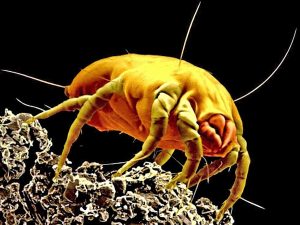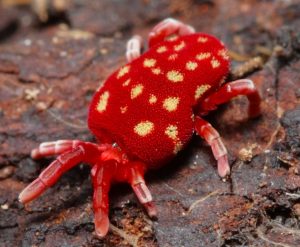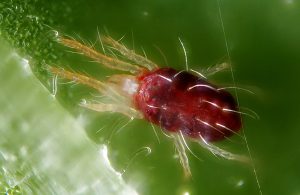Mites (Subclass: Acari) are tiny creatures related to spiders and ticks. They have an oval or round body with eight legs but are so small that you usually can’t see them without a microscope. Depending on their kind and what they’ve been eating, mites can be of different colors, like white, red, brown, or green.
Most mites are between 0.2 and 0.5 millimetres long, smaller than a credit card’s thickness. Even though they are super tiny, mites can live in many places, including your house, and sometimes, they can cause allergies or itchy bites.
How long is the life cycle of a mite?
The lifecycle of mites varies among species but generally includes egg, larval, nymphal, and adult stages. The entire lifecycle can range from a few weeks to several months. For example, a dust mite can complete its lifecycle in about a month under favourable conditions.
Egg Stage: 2-3 days
Larval Stage: 1-2 days
Nymphal Stage: 5-10 days
Adult Stage: Several weeks to a few months
Types of Mites
Common mite types include dust mites, spider mites, and chiggers. Dust mites are prevalent in household dust, while spider mites are often found on plants. Chiggers are notorious for causing itchy bites on humans.




Effective mite control begins with cleanliness. Vacuum and dust your home regularly, especially in areas where dust accumulates. Wash bedding in hot water to kill dust mites. For spider mites, use insecticidal soap or neem oil on affected plants. Learn more about home treatment methods for mites here.
In severe cases, professional mite treatment services may be necessary to eliminate mite infestations comprehensively.
Most mites are too small to be seen without a microscope, but some, like chiggers, can be visible when they cluster on the skin.
Signs of mites include itchy skin, red bites, or allergic reactions such as sneezing and coughing in the case of dust mites.
Dust mites are the most common type found in households, often residing in bedding, carpets, and upholstered furniture.
Mites can cause allergic reactions, skin irritation, and sometimes transmit diseases, leading to discomfort and health issues.
You might get mites through pets, plants, or even on your clothes from infested areas, making it easy for them to enter your home.
If you have Itchy skin, visible bites, or allergic reactions such as sneezing and coughing, there are high chances of mite presence.
Use topical treatments like anti-itch creams or insecticidal shampoos to eliminate mites on the skin effectively.
Mites dislike dry, clean environments as they live in humid, dusty conditions, so keeping your home clean and dry can help keep them away
Yes, mites can infest homes, particularly in areas with high humidity and dust accumulation, leading to potential health issues.
To check for ear mites in cats, look for signs like excessive scratching, head shaking, and dark, crumbly ear discharge that resembles coffee grounds. A vet can confirm the presence of ear mites through a thorough examination.

Get your free pest control estimate today!